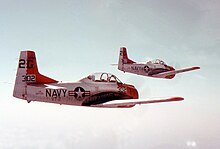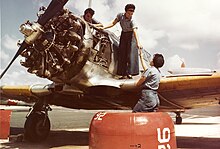
The Beechcraft T-34 Mentor is an American propeller-driven, single-engined, military trainer aircraft derived from the Beechcraft Model 35 Bonanza. The earlier versions of the T-34, dating from around the late 1940s to the 1950s, were piston-engined. These were eventually succeeded by the upgraded T-34C Turbo-Mentor, powered by a turboprop engine. The T-34 remains in service more than seven decades after it was first designed.

Naval Air Station Pensacola or NAS Pensacola, "The Cradle of Naval Aviation", is a United States Navy base located next to Warrington, Florida, a community southwest of the Pensacola city limits. It is best known as the initial primary training base for all U.S. Navy, Marine Corps and Coast Guard officers pursuing designation as naval aviators and naval flight officers, the advanced training base for most naval flight officers, and as the home base for the United States Navy Flight Demonstration Squadron, the precision-flying team known as the Blue Angels.

Naval Air Station Corpus Christi is a United States Navy naval air base located six miles (10 km) southeast of the central business district (CBD) of Corpus Christi, in Nueces County, Texas.

A naval air station is a military air base, and consists of a permanent land-based operations locations for the military aviation division of the relevant branch of a navy. These bases are typically populated by squadrons, groups or wings, their various support commands, and other tenant commands.

Naval Air Station North Island or NAS North Island, at the north end of the Coronado peninsula on San Diego Bay in San Diego, California, is part of the largest aerospace-industrial complex in the United States Navy – Naval Base Coronado (NBC), and the home port of several aircraft carriers of the United States Navy.

A naval aviator is a commissioned officer or warrant officer qualified as a crewed aircraft pilot in the United States Navy or United States Marine Corps. United States Coast Guard crewed aircraft pilots are officially designated as "Coast Guard aviators", although they complete the same undergraduate flight training as Navy and Marine Corps crewed aircraft pilots, and are awarded the same aviation breast insignia.
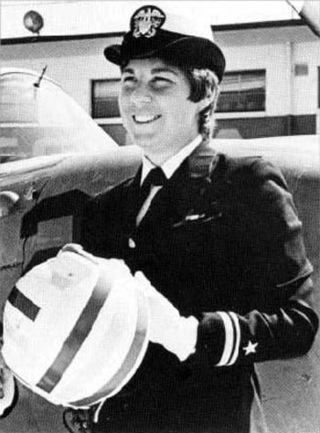
Barbara Ann Allen Rainey was one of the first six female pilots in the U.S. armed forces. Rainey received her wings of gold as the first female to be designated a naval aviator in February 1974 and became the first Navy woman to qualify as a jet pilot. She attained the rank of Lieutenant Commander in the United States Navy. She was killed in an aircraft crash in 1982 while performing her duties as a flight instructor.
Naval Outlying Landing Field Spencer is a military airport located two miles (3 km) northeast of Pace, Florida, United States, in Santa Rosa County. It is owned by the United States Navy. NOLF Spencer is one mile north of U.S. Highway 90, 3.5 miles (6 km) west of the City of Milton, just over 6 miles (10 km) east of the Escambia River and about 7 miles (11 km) southwest of NAS Whiting Field.

Helicopter Training Squadron EIGHT (HT-8) is a United States Navy helicopter training squadron based at Naval Air Station Whiting Field in Milton, FL. The squadron's mission is helicopter pilot training for U. S. Navy, U. S. Marine Corps and U. S. Coast Guard Student Naval Aviators and for selected foreign military flight students from basic helicopter flight training through winging. Student Naval Aviators report to HT-8 for helicopter training upon completion of primary flight training conducted in the T-6B Texan II U. S. Navy primary flight trainer. HT-8 flies the TH-73A Thrasher, an
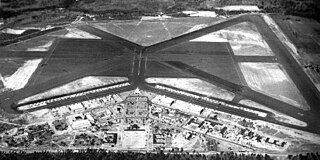
Saufley Field is a military airport and support facility located in unincorporated Escambia County, Florida, United States, five nautical miles (9 km) west of the central business district of Pensacola.
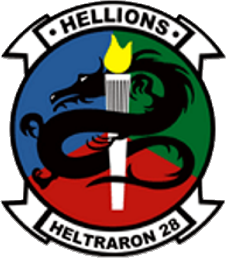
Helicopter Training Squadron 28 (HT-28) is a United States Navy helicopter training squadron based at Naval Air Station Whiting Field in Milton, Florida. The squadron, known as the Hellions, is one of three Advanced Helicopter Training squadrons that produces aviators for the Navy, Marine Corps and Coast Guard. They fall under the command of Training Air Wing Five and fly both the TH-57B Sea Ranger basic helicopter trainer and the TH-57C Sea Ranger advanced helicopter trainer. The squadron's tactical call sign is "Lucky."

Naval Outlying Landing Field Summerdale is an uncontrolled military use airport located in Summerdale, a town in Baldwin County, Alabama, United States. It is under the operational control of NAS Whiting Field and is used for flying training.

The Naval Air Training Command (NATRACOM) is a one-star Echelon III command that conducts flight training of student Naval Aviators, and Naval Flight Officers. Though it does not conduct Naval Aircrew training which is conducted by Naval Education and Training Command's Naval Aviation Schools Command (NASC), it is responsible for monitoring the production of Aircrewmen through the Naval Aviator Production Process (NAPP). Through the NAPP, NATRACOM is also responsible for programming and monitoring the production of all Navy and Marine Corps Fleet Replacement Squadrons.
Naval Air Station New Iberia, located near New Iberia, Louisiana, was a short-lived training facility of the United States Navy which operated for a mere five years in the 1960s. The naval base at New Iberia was actually designated NAAS, indicating that it was a Naval Auxiliary Air Station. The U.S. Navy airfield identifier for New Iberia was KNIL.
The US Navy had four programs for the training of naval aviators.
Naval Outlying Landing Field Barin is a United States Navy airfield located in Foley, a city in Baldwin County, Alabama, United States.

Training Squadron 22 (VT-22) or TRARON TWO TWO, known as the Golden Eagles, callsign "Blazer", is a U.S. Navy strike jet training squadron stationed aboard Naval Air Station Kingsville, flying the T-45C Goshawk. The Golden Eagles are one of four strike jet training squadrons in operation today, and are under the command of Training Air Wing Two.

Training Air Wing ONE is a United States Navy aircraft training air wing based aboard Naval Air Station Meridian, located 11 miles northeast of Meridian, Mississippi in Lauderdale County and Kemper County. TW-1 is one of five training air wings in the Naval Air Training Command, and consists of two jet training squadrons. The wing trains Student Naval Aviators from the U.S. Navy, U.S. Marine Corps, and international allies. Following completion of primary flight training and selection of an advanced training pipeline, Student Naval Aviators are assigned to TW-1 for either intermediate and advanced strike pipeline training or advanced E-2/C-2 training in the T-45C Goshawk jet training aircraft.

Training Squadron SEVEN (VT-7), known as the Eagles, is one of four U.S. Navy strike jet training squadrons and one of two based at Naval Air Station (NAS) Meridian. VT-7, along with Training Squadron NINE (VT-9), make up Training Air Wing One of the Naval Air Training Command. In addition to providing advanced training for strike jets, VT-7 provides additional advanced training for airborne early warning and carrier onboard delivery aircraft. VT-7 also trains United States Marine Corps (USMC) aviators and select foreign military pilots.



